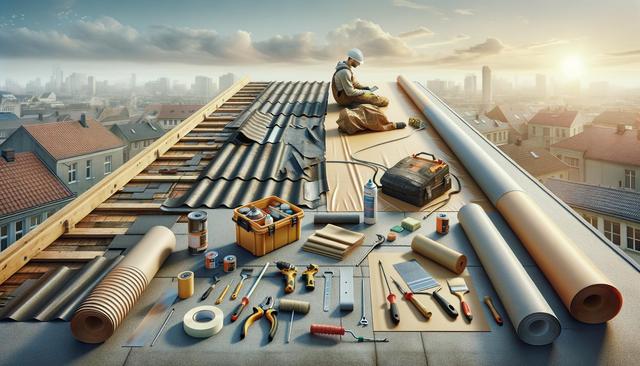Understanding the Basics of Flat Roof Renovation
Flat roof renovation involves multiple stages that ensure the structure remains weather-resistant, energy-efficient, and long-lasting. Unlike pitched roofs, flat roofs require specialized attention due to their minimal slope, which can lead to water pooling and drainage issues. The first step in any flat roof renovation is a thorough inspection. Roofing professionals will evaluate the condition of the existing materials, identify leaks or weak points, and assess the overall structural integrity. This inspection helps determine whether a full replacement is necessary or if targeted repairs will suffice. If you’re considering this type of renovation, it’s wise to get quotes for roofing replacement in {city} from several providers to compare services and pricing.
Common materials used in flat roof projects include:
- Modified bitumen – a durable, weather-resistant option applied in layers
- EPDM rubber – a flexible and easy-to-install synthetic membrane
- TPO – a reflective, energy-efficient material growing in popularity
- Built-up roofing (BUR) – composed of multiple layers of bitumen and fabric
Each material has its own benefits and suitability depending on the climate and building type. Consulting with roofing contractors in {city} can help you select the most appropriate solution for your property.
Steps Involved in a Flat Roof Renovation
The renovation process typically follows a structured sequence to ensure durability and safety. Once the roof has been inspected and the materials selected, the next step is preparing the surface. This includes removing old roofing layers and ensuring the deck underneath is clean and secure. Any damaged wood or insulation is replaced during this phase. Next, a vapor barrier may be installed to protect against moisture buildup.
Following preparation, the chosen roofing material is applied. Each type has a specific method:
- Modified bitumen is often torch-applied or cold-adhered in layers
- EPDM and TPO membranes are usually rolled out and adhered or mechanically fastened
- BUR systems require alternating layers of bitumen and reinforcing fabrics
Proper sealing at seams, edges, and penetrations is critical to prevent water ingress. Finally, a protective coating or gravel layer may be added to extend the roof’s life. Throughout this process, budgeting is essential. Seeking options for budget roof installation in {city} can help manage costs without compromising quality.
Choosing the Right Contractors
Selecting reliable roofing contractors in {city} significantly influences the success of your flat roof renovation. Credentials, experience with flat roofing systems, and transparent pricing structures are key factors to consider. Reputable contractors will provide detailed estimates, timelines, and warranties for their work. It’s advisable to review references, check for proper licensing, and confirm insurance coverage before signing any contract.
When comparing contractors, request information about:
- Previous flat roof projects completed
- Material and labor warranties offered
- Estimated project duration and cleanup procedures
- Post-installation maintenance services
Taking the time to get quotes for roofing replacement in {city} from multiple professionals ensures you can make an informed decision based on both budget and quality.
Budget Planning and Cost Considerations
Flat roof renovations can vary widely in cost based on several factors, including roof size, material choice, labor rates, and any structural repairs required. On average, flat roofing tends to be more economical than pitched alternatives, but complexities like drainage upgrades or insulation improvements can increase the overall price.
To develop a realistic budget, consider:
- Costs for removal and disposal of old materials
- Material pricing and longevity
- Labor costs in your region
- Permit fees and inspection charges
Exploring options for budget roof installation in {city} can help identify cost-saving opportunities, such as using recycled materials or scheduling work during off-peak seasons when contractors may offer discounts. Be cautious of unusually low bids, as these may indicate subpar materials or workmanship.
Maintenance Tips for Long-Term Performance
After a flat roof renovation, ongoing maintenance is vital to preserve the system’s integrity and extend its lifespan. Routine inspections should be conducted at least twice a year, ideally in spring and fall, as well as after heavy storms. During these checks, look for signs of damage, such as cracks, blisters, or ponding water.
Preventive maintenance tasks include:
- Clearing debris from drains and gutters
- Checking and resealing flashing and edges
- Keeping rooftop equipment securely fastened
- Applying reflective coatings when needed
Establishing a maintenance schedule with roofing contractors in {city} ensures timely repairs and helps avoid costly damage. Many providers offer service plans tailored to flat roofs, which can be a worthwhile investment in protecting your property.
Conclusion: Planning a Successful Flat Roof Renovation
Flat roof renovation is a practical investment that enhances building performance and resilience. From selecting durable materials to hiring experienced contractors, each step plays a crucial role in achieving a successful outcome. Whether your goal is to improve insulation, fix leaks, or replace an aging structure, it’s important to get quotes for roofing replacement in {city} to understand your options and costs. By working with knowledgeable roofing contractors in {city} and exploring choices for budget roof installation in {city}, property owners can ensure a smooth renovation process that delivers long-term value and protection.




Leave a Reply